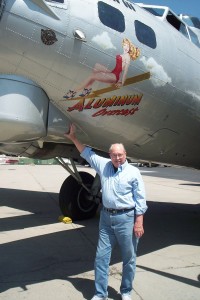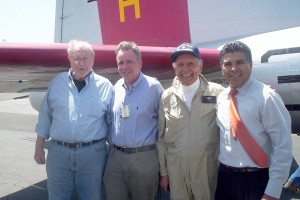
The Experimental Aircraft Association’s B-17G Aluminum Overcast, in front of the Syncro Aviation hangar at Van Nuys Airport, was on its yearly “Keep It Flying” tour.
By Fred “Crash” Blechman
On April 19 at 11 a.m., the drone of a World War II aircraft could be heard above Van Nuys Airport, even before the four-engine bomber came into view. The Experimental Aircraft Association’s B-17G Flying Fortress, Aluminum Overcast, landed on Runway 16R and taxied to the area in front of the huge Syncro Aviation hangar.
The B-17, available to the public for rides April 20-22, is one of only 12 still flying today, out of the 12,731 Flying Fortresses that were built from 1935 to 1945. This was the sixth stop on Aluminum Overcast’s annual “Keep It Flying” tour around the country. Elliot Sanders, Van Nuys Propeller Aircraft Association president, was in charge of promoting the B-17 visit. Anne Marie Radel, a member of the Ninety-Nines, coordinated that tour stop.
Arriving a day early for media coverage, members of the press joined several WWII veterans who boarded the plane for an early afternoon flight. Dan Bowlin was the pilot for this flight and Rick Fernalld was copilot. Bowlin, with more than 30,000 hours, was an Air Force pilot and then flew for several airlines before retiring in 2003 as a Boeing 747 captain. Fernalld flew Boeing B-52s in Southeast Asia and C-141s in Desert Storm and Desert Shield. He had been flying for 42 years when he retired from the Air Force in 1994. Two WWII B-17 pilots from the “The Bloody Hundredth” bomb group were on this flight. Lt. John Bockhorst, 83, was 21 years old when he flew his 26th and last mission over Germany 62 years ago as a pilot in the 350th Squadron. He said he never expected to survive the war.

Former B-17 World War II pilot Lt. John Bockhorst completed 26 combat missions when he was 21. He hadn’t been in a B-17 for more than 62 years.
Lt. Col. Henry “Hank” Cervantes, 83, a pilot in the 349th Squadron, was a farm worker before the war. He went on to develop supersonic aircraft after the war was over, as described in his book, “Piloto: Migrant Worker to Jet Pilot.” During the war, a Luftwaffe fighter rammed his plane into Cervantes’ B-17, destroying its rudder and left elevator. But Cervantes still managed to make it through the fog and safely land at his home base.
Los Angeles City Councilman Tony Cardenas and his aide were also on the April 19 demonstration flight.
“It’s always exciting to imagine what our men had to go through during battles and what they had to endure to defend our democracy during the war,” Cardenas commented.
As the passengers embarked through the right rear door, they found canvas seats in the rear area of the plane, plus seats in the nose, radio and navigator positions. The guests had to make their way around waist guns, the ball turret and the narrow bomb bay walkway. Cardenas noted how cramped it was.
“I can’t imagine tall guys getting through here,” he said. “This place is all business—not for luxury.”
With everyone seated and belted for takeoff, the plane taxied out and lined up on Runway 16R. Each of the four Curtiss-Wright 1,200-hp engines went to full power. The interior noise increased as the B-17 rumbled down the runway and took off at 1:15 p.m.
Turning slightly west, the plane climbed toward 2,000 feet, and the Pacific Ocean came into view. The B-17 then flew over the Santa Monica Mountains. The weather was clear, and the passengers were able to move around and check out the views.
After reaching Pacific Palisades, the plane turned west and flew about a mile inland, paralleling the Malibu beaches and the Pacific Coast Highway, almost to Point Dume. Then the B-17 turned northeast towards the San Fernando Valley. It descended as it entered the Van Nuys Airport pattern and made a right-hand approach to 16R at 1:35 p.m.

L to R: Lt. John Bockhorst, writer Dana Bartholomew, WWII B-17 pilot Lt. Col. Henry Cervantes and Los Angeles City Councilman Tony Cardenas enjoyed a demonstration flight on Aluminum Overcast.
Cardenas agreed with other passengers that the trip back into time was fun.
“That’s because nobody was shooting at us!” he quipped.
For more information about this year’s tour, visit [http://www.b17.org] or call 1-800-359-6217.











